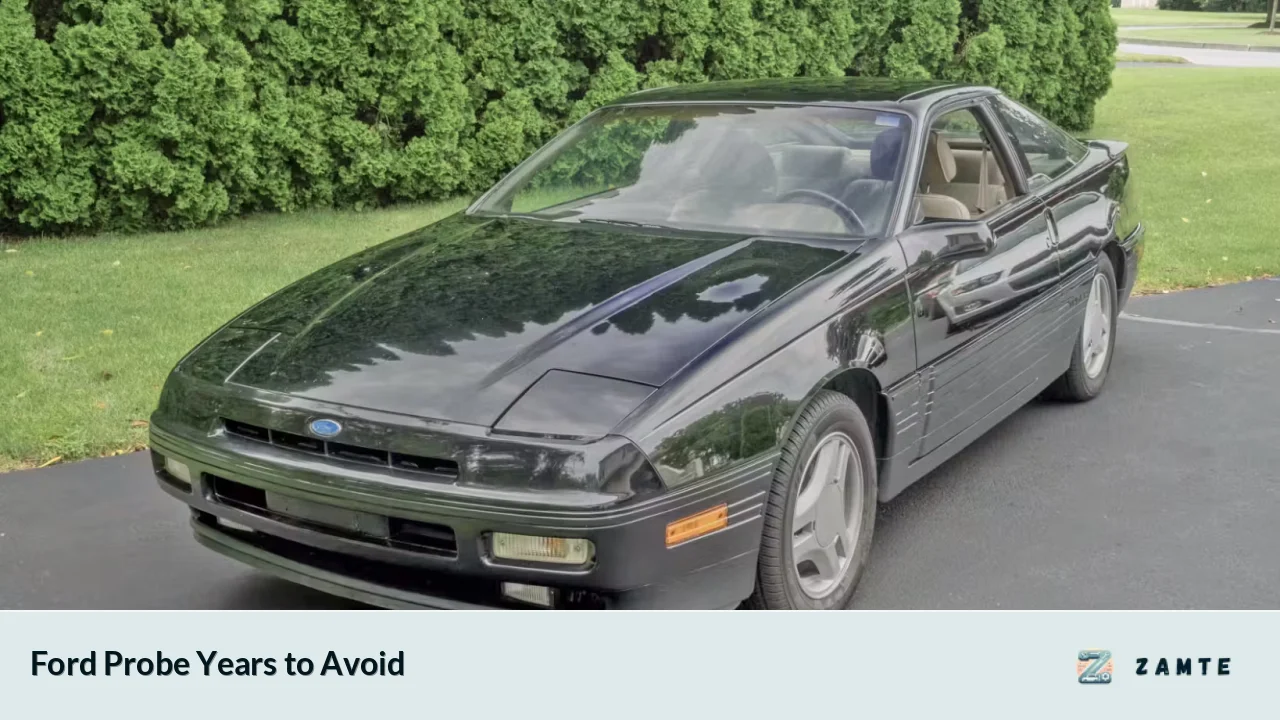The Ford Probe, a sporty coupe produced from 1989 to 1997, has had its share of ups and downs. While some model years were praised for their performance and style, others were plagued with issues that potential buyers should be aware of. This article will delve into the Ford Probe years to avoid, common problems, and what to look out for when considering this vehicle.
| Model Year | Reliability Rating | Common Issues |
|---|---|---|
| 1989-1992 | 2/5 | Engine problems, transmission issues, electrical failures |
| 1993-1995 | 3/5 | O2 sensor failures, distributor problems, brake issues |
| 1996-1997 | 3.5/5 | Improved reliability, but still some electrical concerns |
The Troubled First Generation (1989-1992)
The first generation of the Ford Probe, spanning from 1989 to 1992, is generally considered the most problematic. These early models suffered from a variety of issues that make them less desirable for used car buyers[1].
Engine Problems: One of the most significant issues with the first-generation Probe was its engine reliability. Many owners reported frequent overheating, oil leaks, and premature engine failure. The 2.2-liter four-cylinder engine, in particular, was prone to head gasket failures and timing belt issues[1].
Transmission Woes: Another area of concern for the 1989-1992 Probes was the transmission. Both manual and automatic transmissions were known to fail prematurely, with some owners reporting complete transmission failure as early as 60,000 miles[1].
Electrical Gremlins: Electrical problems were rampant in the first-generation Probes. Issues ranged from faulty alternators and starters to more complex problems with the engine control module (ECM). These electrical issues often led to starting problems and unexpected stalling[1].
The Improved Second Generation (1993-1997)
While the second generation of the Ford Probe (1993-1997) saw significant improvements in overall quality and reliability, it wasn't without its own set of issues.
O2 Sensor Failures: One of the most common complaints among second-generation Probe owners was frequent O2 sensor failures. These sensors are crucial for proper engine performance and fuel efficiency. Failure can lead to poor gas mileage and rough running conditions.
Distributor Problems: The 1993-1995 models, in particular, were prone to distributor failures. This issue often manifested as intermittent starting problems or complete failure to start. The problem was usually caused by a faulty ignition control module located inside the distributor.
Brake System Issues: Some owners reported premature wear of brake components, particularly in the GT models. This included warped rotors and frequent need for pad replacements.
The Later Years: 1996-1997
The 1996 and 1997 model years are generally considered the most reliable of the Ford Probe lineup. Ford had addressed many of the earlier issues, resulting in a more dependable vehicle.
Improved Reliability: These later models benefited from several years of refinement, with fewer reported engine and transmission problems compared to earlier years.
Electrical Concerns: While significantly improved, some electrical issues persisted in these models. However, they were less frequent and typically less severe than in earlier years.
What to Look for When Buying a Used Ford Probe
If you're considering purchasing a used Ford Probe, here are some key points to keep in mind:
- Avoid First Generation Models: Unless you're prepared for potential headaches, it's best to steer clear of the 1989-1992 models.
- Check Service History: Look for vehicles with comprehensive service records, especially for timing belt replacements and transmission services.
- Inspect for Rust: Probes were prone to rust, particularly around the wheel wells and underbody. A thorough inspection is crucial.
- Test All Electrical Components: Given the Probe's history of electrical issues, ensure all electrical systems are functioning properly.
- Consider a Pre-Purchase Inspection: Having a trusted mechanic inspect the vehicle before purchase can save you from costly surprises down the road.
Conclusion
While the Ford Probe had its share of problems, particularly in its early years, later models offered improved reliability and performance. By being aware of the common issues and knowing which years to avoid, you can make a more informed decision when considering a Ford Probe as your next vehicle.
FAQs
- Which Ford Probe years should I avoid?
The 1989-1992 models are generally considered the least reliable and should be avoided if possible. - What are the most common problems with Ford Probes?
Common issues include engine problems, transmission failures, electrical issues, and O2 sensor failures. - Are there any Ford Probe years that are considered reliable?
The 1996-1997 models are generally regarded as the most reliable of the Ford Probe lineup. - What should I look for when buying a used Ford Probe?
Check for a comprehensive service history, inspect for rust, test all electrical components, and consider a pre-purchase inspection. - Is the Ford Probe a good car overall?
While it had its issues, later models of the Ford Probe can be good cars if well-maintained and properly cared for.
